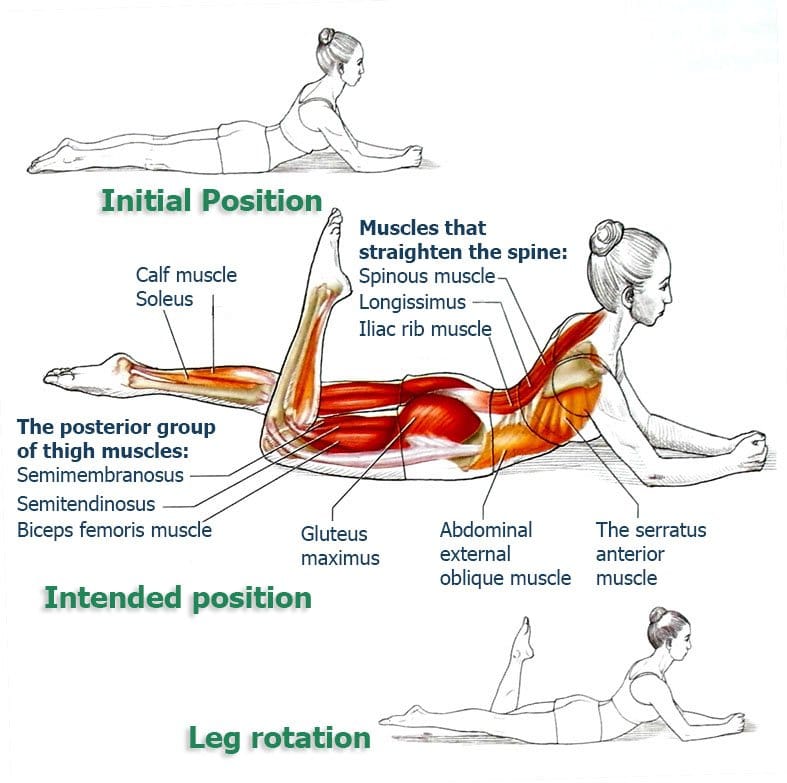Congratulations for making it this far! After you conquer today’s exercise, Pilates Leg Kick, your back and core should already be in a much better condition then before you started this program. These erector spinae exercises are essential to anybody who tends to sit a lot. By implementing our stretching routine, you’ll strengthen all the muscles that support your spine, improving your posture and making daily activities that stress your back a breeze. If you’ve had a spinal or back injury, consult with your doctor before you start the program.
The series so far:
- Exercise #1: Cat-Cow
- Exercise #2: Back Extension
- Exercise #3: Back Stretching
- Exercise #4: Pilates Leg Kick (you are here)
- Exercise #5: Double Impact
- Exercise #6: Swimming
- Exercise #7: Stomach Rolls
- Exercise #8: Diving Swan
Please make sure to take your time with each exercise before progressing further down the order. This ensures you avoid injuries and tackle each exercise already prepared.
Erector Spinae Exercises – Pilates Leg Kick

Initial position. Lie on your stomach and leaning on the arms, lift the upper torso. The forearm should be placed so that the angle between the shoulder and the body was about 90 degrees. The hands are clenched into fists and touching each other. Legs are extended and closed, toes slightly pointed.
- Inhale: lift both legs about 5 cm from the floor. Vigorously bend one leg at the knee, trying to touch the buttocks with the heel;
- Exhale: in the same energetic movement straighten your leg at the knee, bending the other one and going for the buttocks. Repeat the exercise 20 times (10 per leg).
Make Sure You:
- Stretch the abdominal muscles during the exercise. Try to pull them up to limit the forward tilt of the pelvis;
- When raising the upper body control the lean with the forearms on the mat. This will activate the extensor arm muscles in the shoulder joint, and the extensors of the back. At the same time slightly lower and ease the shoulder blades;
- In the intended position, lift the feet off the mat only to such a height that allows you to do the exercise without tilting the pelvis forward. Keep legs at this height during the entire exercise;
- In the intended position, when bending the leg at the knee joint for a ‘heel kick’ towards the buttocks, the power and amplitude of this movement should not cause discomfort in the knee;
- Keep the movement of the feet locked in the knee joints. The body, however, must remain stable and motionless.
Additional Notes
Pilates Leg Kick has an important place in our stretching program. It is a very useful exercise for strengthening the stability of the back muscles. The erector spinae extensors hold the body of the mat with some additional support from the arms. The movement of the feet is aimed at trying to challenge this stability and simultaneously improve tone and endurance of the back and thigh muscle groups, which is necessary not only to keep the feet in the air, but also to bend the knees.
As with the previous erector spinae exercises, the abdominal muscles play an important stabilizing function, limiting the forward tilt of the pelvis and avoiding hyperextension of the lumbar spine. This is a crucial skill you’ll find invaluable for the more complex exercises later in this program.
Modifications
If you feel discomfort in your back, limit the extension of the erector spinae by moving your elbows a little further forward with the head resting on the hands.
On the other hand, if you place your elbows just below the shoulder joints, you’ll increase the extension of the spine and give the back and abdominal muscles a bigger load (which means extreme caution should be exercised).
Source: SportWiki.to

